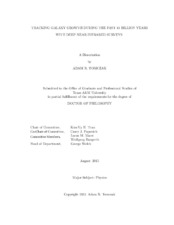| dc.description.abstract | Using observations from the FourStar Galaxy Evolution Survey (ZFOURGE), we obtain the deepest measurements to date of the galaxy stellar mass function (SMF) at z < 3. With these data, we find evidence for a steepening of the slope at the low-mass end of the SMF at z ≤ 2, a feature that had only been identified at z ≤ 1. These measurements also allow us for the first time to observe a rapid buildup of low-mass quiescent galaxies and help to constrain the growth rates of galaxies.
We next explore star-formation histories (SFHs) of galaxies based on the evolution of the correlation between the star-formation rate and stellar mass of galaxies (SFR−M∗) and compare to the buildup of stellar mass predicted from the evolution of the SMF. By integrating along the SFR−M∗ sequence we generate differential SFHs and estimate stellar mass-growth histories. We find that these integrated SFHs are in broad qualitative agreement with the SMF, but that they do disagree in detail. At early times the SFHs suggest mass-growth rates that are as much as 0.5 dex higher than inferred from the stellar mass function.
Lastly, we look into the prevalence of a possible source of feedback preventing star-formation using mid-IR data from the Spitzer Space Telescope with established color selection criteria to identify galaxies hosting active galactic nuclei (AGN). Of the 949 cluster galaxies in our IR-detected sample we identify 12 that are consistent with hosting AGN. We thus measure the fraction of cluster galaxies that host an IR-AGN for a magnitude-limited subsample (fIR−AGN) to be ≈ 0.6% with a strong upper limit of 3.4% at the 99% confidence level at z < 1. Our results suggest that fIR−AGN in massive galaxy clusters is not strongly correlated with star formation at z < 1, and that IR-AGN have a more prominent role at z > 1. | en |


